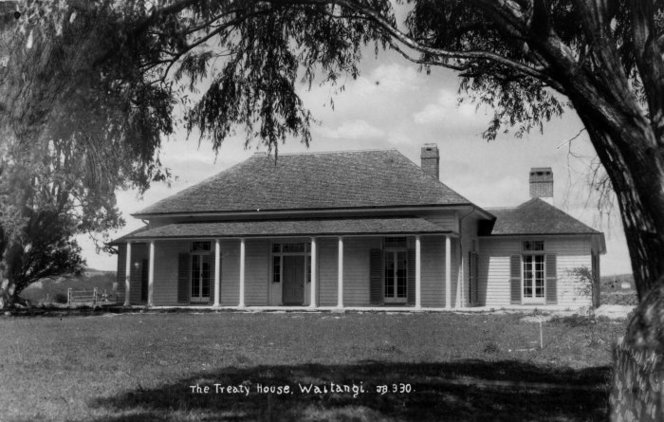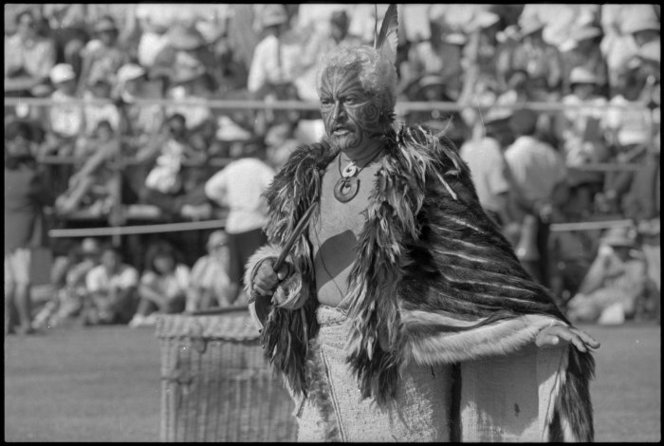The Treaty of Waitangi was signed by a total of 43 chiefs on the 6th of February 1840 at Waitangi in the Bay of Islands. Several copies were then made in Te Reo Māori which were sent around the country to be signed.

In 1839 Captain William Hobson was sent to replace James Busby and act for the British Crown as Lieutenant-Governor. He was to negotiate a treaty with the Māori under specific instructions from the Secretary of State for the Colonies, Lord Normanby, by which New Zealand would become a British colony and the sovereignty of the country would be transferred to the British Crown.
... the increase in national wealth and power, promised by the acquisition of New Zealand, would be a most inadequate compensation for the injury which must be inflicted on this kingdom itself by embarking in a measure essentially unjust, and too certainly fraught with calamity to a numerous and inoffensive people whose title to the soil and to the sovereignty of New Zealand is indisputable ...
Lord Normanby. No. 6.The Marquis of Normanby to Captain Hobson, R.N. A Compendium of Official Documents Relative to Native Affairs in the South Island, Volume One. New Zealand Electronic Text Collection.
Hobson arrived in Waitangi on 29 January 1840 and immediately issued invitations to several hundred Māori to come to Waitangi on Wednesday 5 February. In the days between, Hobson, with help from Busby, had drawn up a treaty in English. This text was then translated into Māori by the missionary Henry Williams and his son, Edward, on the evening of 4 February.
Hobson speaks
Hobson told the group that he had been sent to New Zealand to be its governor, but that this would need to be agreed to by the chiefs. He spoke in English, and then Henry Williams translated his words into Māori. Hobson then read out the final draft in English of the Treaty, followed by Henry Williams who read out the Māori translation.
Treaty debate
The Treaty was then debated for the next five hours. The northern chiefs Hone Heke and Tamati Waka Nene favoured signing the Treaty and eventually convinced the other chiefs to follow their lead. The talking amongst the Māori continued into the night, and by the next day they had decided to sign the Treaty and return home. A meeting had not been planned for Thursday 6 February, but Hobson agreed that those who wanted to sign the Treaty should, as long as there was no further discussion. Prompted by the Catholic Bishop Pompallier, Hobson also agreed that people in New Zealand could follow any religion they chose, including Māori custom. This has been described as the ‘Fourth Article’ of the Treaty.

The chiefs sign
The meeting or hui between Māori and the British Crown began on Wednesday 5 February 1840 in a large tent, made out of ships’ sails, which had been put up on the lawn in front of James Busby’s house. The house later became known as The Treaty House. The first Māori to sign was Hone Heke the following morning on the 6th of February, although three other chiefs signed above his signature later.
The Treaty of Waitangi was signed by a total of 43 chiefs on the 6th of February 1840 at Waitangi in the Bay of Islands. Several copies were then made in Te Reo Māori which were sent around the country to be signed. By the end of 1840 around 500 chiefs had signed including 13 women. Only 39 Māori signed an English copy of the Treaty.
![New Zealand. Department of Maori Affairs. Artist unknown :[Reconstruction of the signing of the Treaty of Waitangi. ca 1940]. Ref: A-114-038. Alexander Turnbull Library, Wellington, New Zealand. http://natlib.govt.nz/records/22701985](https://christchurchcitylibraries.com/Kids/Treaty-Zone/imgs/22701985.jpg)
The Treaty travels
After the official signing, the Māori text of the Treaty was taken around Northland to be signed by more Māori, while several copies were sent elsewhere in New Zealand. The English text copy was also signed at the Waikato Heads and at Manukau.
Recommended resources
- Waitangi Treaty copy Ministry for Culture and Heritage
- Treaty sheets and signing locations Ministry for Culture and Heritage
- Claudia Orange. Treaty of Waitangi, Te Ara - the Encyclopedia of New Zealand
- Waitangi – What really happened? A dramatization of the signing of the Treaty with re-imagined dialogue. Includes adult content. NZ On Screen.
- The Authentic and Genuine History of the Signing of the Treaty of Waitangi by William Colenso who was present during the February 6th signings at Waitangi.
Next page: South Island signings

